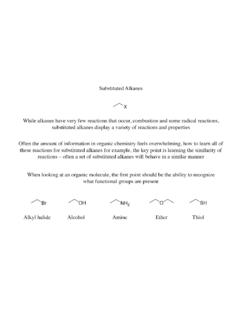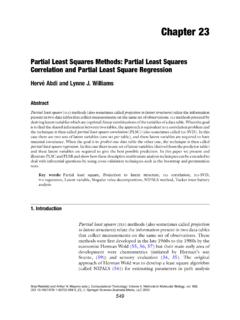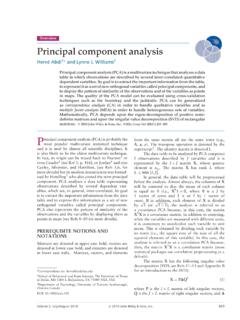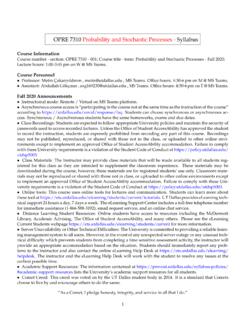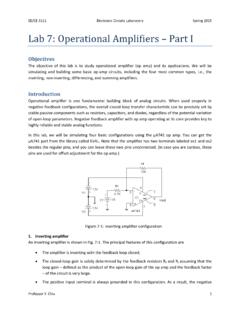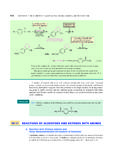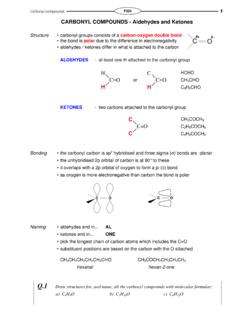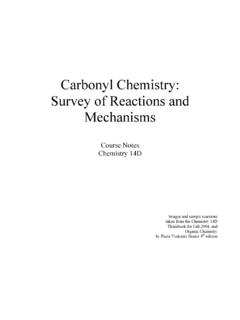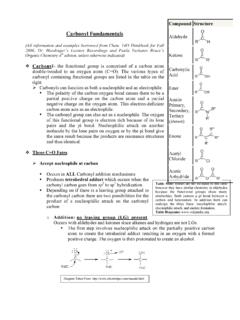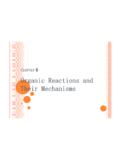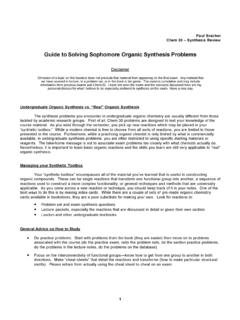Transcription of Reactions of Aromatic Compounds Aromatic compounds are ...
1 Reactions of Aromatic Compounds Aromatic Compounds are stabilized by this Aromatic stabilization energy Due to this stabilization, normal SN2 Reactions observed with alkanes do not occur with Aromatic Compounds (SN2 Reactions never occur on sp2 hybridized carbons!) In addition, the double bonds of the Aromatic group do not behave similar to alkene Reactions Aromatic Substitution While Aromatic Compounds do not react through addition Reactions seen earlier Br2 BrBrBr2 FeBr3 BrWith an appropriate catalyst, benzene will react with bromine The product is a substitution, not an addition (the bromine has substituted for a hydrogen) The product is still Aromatic Electrophilic Aromatic Substitution Aromatic Compounds react through a unique substitution type reaction Initially an electrophile reacts with the Aromatic compound to generate an arenium ion (also called sigma complex) The arenium ion has lost Aromatic stabilization (one of the carbons of the ring no longer has a conjugated p orbital)
2 Electrophilic Aromatic Substitution In a second step, the arenium ion loses a proton to regenerate the Aromatic stabilization The product is thus a substitution (the electrophile has substituted for a hydrogen) and is called an Electrophilic Aromatic Substitution Energy Profile Potential energy Reaction Coordinate Starting material Transition states Transition states Intermediate Products EHEThe rate-limiting step is therefore the formation of the arenium ion The properties of this arenium ion therefore control electrophilic Aromatic substitutions (just like any reaction consider the stability of the intermediate formed in the rate limiting step) 1) The rate will be faster for anything that stabilizes the arenium ion 2) The regiochemistry will be controlled by the stability of the arenium ion The properties of the arenium ion will predict the outcome of electrophilic Aromatic substitution chemistry Bromination To brominate an Aromatic ring need to generate an electrophilic source of bromine In practice typically add a Lewis acid ( FeBr3) to bromine In presence of Aromatic ring this electrophilic bromine source will react Br2 FeBr3 BrHBrWith unsubstituted benzene the position of reaction is arbitrary With a monosubstituted Aromatic ring, however, can obtain three possible products How to predict which is favored?
3 Controlled by stability of arenium ion intermediate The stability is different depending upon placement of carbocation Alkyl groups are electron donating Therefore toluene will favor electrophilic substitution at ortho/para positions (only ortho/para substitution places carbocation adjacent to alkyl group on ring) Often obtain more para than ortho due to sterics In addition to orientational control, substituents affect reactivity CH3NO2As the Aromatic ring acquires more electron density, the arenium ion will be more stable Toluene therefore reacts faster in an electrophilic Aromatic substitution than benzene The alkyl group is called an activating group (it activates the ring for a faster rate) Any substituent that increases the rate for an electrophilic Aromatic substitution is called an activating substituent Substituents that lower the rate for an electrophilic Aromatic substitution are called deactivating subsituents (nitro is one example of a deactivating group) These are groups that lower the electron density of the Aromatic ring Factors that affect Activators/Deactivators There are in general two mechanisms that can affect a substituent 1) Inductive Substituents that are more electronegative than carbon will inductively pull electron density out of the ring 2)
4 Resonance Substituents that have a lone pair of electrons adjacent to the ring can donate electron density into the ring through resonance OCH3 OCH3 OCH3 OCH3 Many substituents will have both inductive and resonance effects Need to balance the effects RAlkyl substituents inductively donate, no resonance effects, therefore activators Electronegative atoms with lone pair of electrons have opposing effects Inductively withdrawing therefore deactivating Resonance donating, therefore activating ZZ when a neutral O or N is directly bonded to a benzene ring, the resonance effect dominates and the net effect is activating when a halogen is bonded to a benzene ring, the inductive effect dominates and the net effect is deactivating Other Deactivating Groups There are two other main classes of deactivating groups 1) A conjugated system where both inductive and resonance effects pull electron density from the ring YZWhenever Z is more electronegative than Y as seen in structure NOOON2) A formal positive charge is placed directly adjacent to ring NCH3H3 CCH3 Activating vs.
5 Deactivating Ability can be compared The substituents can be compared relatively Orientational Control Can Be Predicted 1) All activating groups favor ortho/para substitution 2) Deactivating groups with a lone pair of electrons adjacent to the ring favor ortho/para substitution (halogens are in this category) 3) Other deactivating groups favor meta substitution With deactivating groups besides halogens, the favored substitution is meta Can be predicted by stability of arenium ion Only the meta substitution does not place a carbocation adjacent to EWG All positions with a deactivating group are slower than benzene * The meta position is the LEAST disfavored Consider reaction coordinate for the first, rate-determining step Multiple Substituents How to determine orientation of electrophilic Aromatic substitution if there is more than one substituent? A few rules to consider: 1) The effects are cumulative 2) The stronger substituent according to the relative effects will be correspondingly more important for directing effects 3) When given a choice, a new substituent typically will not go ortho to two other substituents Consider some examples.
6 Ortho/para director CH3 CNBr2 FeBr3meta director CH3 CNBrH3 CCNBr2 FeBr3ortho/para director meta director H3 CCNBrBr2 FeBr3H3 COCH3ortho/para director ortho/para director H3 COCH3 BrStronger director wins Stronger director wins Reactivity of Aromatic ring can affect amount of reaction In Reactions with strongly activated rings, polyhalogenation occurs With either phenol or aniline, the reaction will proceed until all ortho/para positions are reacted when catalyst is used With these highly activated ring systems, catalyst is not necessary Reaction will only proceed with strongly activated ring systems, still need catalyst for less activated Aromatic rings, but with phenol or aniline reaction of one halogen can occur with no catalyst present Other Electrophiles Beside Bromine Chlorination reaction is similar to bromination Often use Lewis acid with chlorine substituents to avoid cross contamination ( often use AlCl3 for chlorination but FeBr3 for bromination)
7 Also with strongly activated rings obtain polychlorination products with catalyst Iodination requires a stronger oxidizing reagent The reagents are a method to generate iodonium ion in situ The iodonium can then react as the electrophile Fluorine is much harder to add in an electrophilic addition There is not an easy method to generate F+ Typically to add fluorine to an Aromatic ring a diazonium route is used This chemistry will be dealt in more detail in chapter 19 Other Common Electrophiles Besides Halogens Nitration Adding a nitro group to an Aromatic ring is a convenient and useful reaction Need to generate a source of nitronium ion An advantage of nitration is the nitro group can be reduced to an amine Allows the introduction of an amine group to the Aromatic ring (almost all Compounds that contain a nitrogen attached to Aromatic ring occurred through a nitration) This conversion changes the electronic properties of the ring Nitro Deactivating/Meta Director Amine Activating/Ortho-Para Director Sulfonation Allows the introduction of a sulfur group (many biological/medicinal uses)
8 The reverse step can also occur The desulfonation step allows introduction of isotopes Occurs through arenium ion where compound is sulfonated, then add D+ and desulfonate to eliminate sulfur and add deuterium Friedel-Crafts Alkylation In general carbon-carbon bonds can be made by reacting an Aromatic ring with a carbocation This reaction is called a Friedel-Crafts alkylation The key is formation of electrophilic carbon The alkyl halide reacts with the Lewis acid With tertiary and secondary alkyl halides this generates a discrete carbocation With primary alkyl halides the full carbocation is not formed Any method that generates a carbocation can be used in a Friedel-Crafts alkylation Two other common methods: 1) From alkenes Often use HF as acid source since fluoride is weak nucleophile, therefore higher lifetime of carbocation to react 2) From alcohols Limtations of Friedel-Crafts Alkylation 1) Reaction does not work with strongly deactivated Aromatic rings Friedel-Crafts alkylations do not work with nitro, sulfonic, or acyl substituents 2) Carbocation rearrangements occur Because a carbocation is formed during this reaction, similar to any reaction involving carbocations the carbocation can rearrange to a more stable carbocation Can therefore never obtain n-alkyl substituents longer than 2 carbons 3) Polyalkylation often occurs with Friedel-Crafts alkylation Because an alkyl group is an activating group, the product is more reactive than the starting material Causes the product to react further To prevent polyreaction the starting material (benzene is this example)
9 Is used in excess Another Option: Friedel-Crafts Acylation Instead of adding an alkyl group this reaction adds an acyl substituent First need to generate an acid chloride Thus any carboxylic acid can be converted into an acid chloride The acid chloride can then be reacted in a Friedel-Crafts acylation First form an acylium ion by reacting with Lewis acid The acylium ion then reacts with Aromatic ring in a typical electrophilic Aromatic substitution Advantages of Friedel-Crafts Acylation 1) The acyl substituent is a deactivating group Therefore this reaction can be stopped easily at one addition (no polyacylation occurs) 2) No rearrangements occur Since an isolated carbocation is not formed there is no rearrangement Due to these two advantages, the Friedel-Crafts acylation is a much more convenient reaction than the Friedel-Crafts alkylation -still will not react with strongly deactivated Aromatic rings High para substitution preference Due to the steric bulk of the Friedel-Crafts acylation reagent, often see a high preference for the para substitution with an ortho/para directing group *often see para preference with bulky electrophiles Clemmensen Reduction The ability to reduce a carbonyl to a methylene further enhances usefullness of Friedel-Crafts acylation In a Clemmensen reduction the conversion occurs under acidic conditions Overall these two steps, Friedel-Crafts acylation followed by Clemmensen.
10 Allows the introduction of an n-alkyl substituent which would not be possible with a Friedel-Crafts alkylation Wolf-Kishner Reduction Another method to reduce a carbonyl to methylene is a Wolf-Kishner reduction Main difference is that the Wolf-Kishner occurs under basic conditions Both Clemmensen and Wolf-Kishner require strong conditions, Clemmensen uses acidic while Wolf-Kishner uses basic conditions Benzaldehyde Adding a formyl group requires stronger conditions than an acyl group addition Cannot isolate formyl chloride Therefore normal Friedel-Crafts acylation conditions cannot be used Need to generate in situ Birch Reduction In addition to adding electrophiles to Aromatic ring, the Aromatic ring can be reduced by adding electrons to the system (in essence a nucleophilic addition) The electrons need to be generated in situ This electron is called a solvated electron In the presence of an Aromatic ring this electron will react Addition of one electron thus generates a radical anion This strongly basic anion will abstract a proton from alcohol solution eThe radical will then undergo the same operation a second time The final product has thus been reduced from benzene to a 1,4-cyclohexadiene The Aromatic stabilization has been lost Orientation of Birch Reduction What happens if there is a substituent on the Aromatic ring before reduction?
